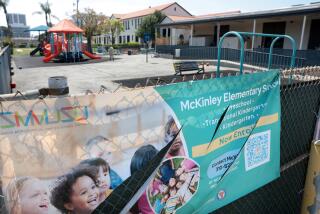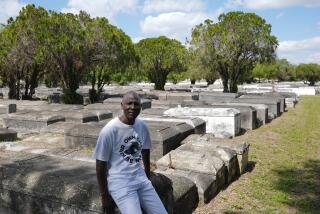Challenge at Chicago school construction site: Watch for 38,000 unmarked graves
Reporting from CHICAGO — A 15-year effort to build a school in Chicago’s Dunning neighborhood is underway with an unusual complication: Construction workers are taking careful steps to avoid disturbing human remains that may lie beneath the soil.
The $70-million school is to be built on the grounds of a former Cook County Poor House, where an estimated 38,000 people were buried in unmarked graves. Among the dead are residents who were too poor to afford funeral costs, unclaimed bodies and patients from the county’s insane asylum.
“There can be and there have been bodies found all over the place,” said Barry Fleig, a genealogist and cemetery researcher who began investigating the site in 1989. “It’s a spooky, scary place.”
Workers have until April 27 to excavate and clear the site, remediate the soil and relocate an existing sewer line. The school is scheduled to open in time for the 2019-20 academic year, though a spokesperson for Chicago Public Schools would not say what type of school it will be.
“I’m sure they’re gonna be on top of some graves, but this is progress,” Alderman Nicholas Sposato said.
At 135,000 square feet, the school will accommodate about 1,200 students, according to Sposato.
Fleig said he’s “nearly certain” there are no intact caskets buried underneath the proposed school grounds — bodies were primarily buried in two formal cemeteries, though scattered human remains have been discovered during previous construction projects nearby.
Children, patients from an infirmary and a tuberculosis hospital, victims of the Great Chicago Fire of 1871 and Civil War veterans were laid to rest in what is known as the Dunning grounds, a 320-acre stretch on the city’s Northwest Side.
In 1854, the county opened a poorhouse and farm and gradually added an insane asylum, infirmary and tuberculosis hospital to the property. Up to 1,000 people were buried on the grounds each year.
The state took over in 1912 and changed the official name to Chicago State Hospital. Buildings were shuttered in 1970 and operations moved to what is now Chicago-Read Mental Health Center.
In the years after Chicago State Hospital closed, the state sold a bulk of the land to development firms. Today, the cemeteries are bounded by restaurants, businesses, houses and condominiums.
Bodies were unearthed in the Dunning neighborhood by workers who were building single-family homes and installing sewer lines in 1989 and again in 1995, the Tribune reported at the time. No human remains have been found since the city began probing the school site in 2013, according to Bryant Payne, a spokesman with the city’s Public Building Commission.
David Keene, an archaeologist who was hired to examine the site in 1990, oversaw pre-construction trenching for the school project to search for human remains, burial sites or cemeteries, but didn’t find anything. Still, Payne said the agency drafted a five-page plan to guide workers on how to deal with potential discoveries as they build the school.
Workers are encouraged to use plastic or rubber shovels and scoops during construction. They’re required to keep plastic bags for small bones and artifacts, plastic tubs, gloves and photo equipment on site.
Should they come across intact graves, officials will set up a perimeter with police tape, post warning signs and secure the area. The architects would then go in and remove the coffins and grave artifacts, place them in plastic storage containers and move them to a staging area before resuming work.
The Illinois State Museum has jurisdiction over any human remains that are discovered, per the Human Skeletal Remains Act.
Museum officials said they would work with the Illinois Department of Natural Resources to establish a final resting place, if necessary. Dawn Cobb, an archaeologist with the agency’s Office of Realty and Environmental Planning, said there is a “strong likelihood” that any remains would go to Dunning Memorial Park.
Jeanne Lambin, 48, was part of an archaeology team hired to investigate the Dunning grounds in 1989 shortly after a backhoe operator struck a corpse while developing condos. The state had recently passed a law requiring archaeological assessments before construction on any property where human remains were discovered.
At the time, Lambin was a 19-year-old freshman at Loyola University who joined the crew for on-site learning and training.
“Once you got the topsoil off to start digging down, you could see the outlines of the coffins,” Lambin said. “These bodies would emerge — I know that’s a really creepy and weird thing for some people but for me, it was about getting to know someone in this really interesting way. The bodies tell stories.”
By then, corpses had been buried at Dunning for more than a century. Lambin said some of the bodies had been buried with jewelry, glass beads, Bibles, coins and other artifacts. Mothers were buried with infants.
“For a lot of them, you could tell where their hands had been placed,” she said. “It was absolutely incredible.”
Lambin said she worked on two different sections of the dig site. In one area, the soil was easy to dig through and the bodies were intact in individual coffins. Digging in the second section was a much “creepier” and “disconcerting” experience, she said. Excavators also found “jumbles of bones” in a mass grave.
Bodies were removed from the site, catalogued and analyzed in the lab, and reburied at Oak Park Cemetery in small coffins.
“It was a really profound experience to go through the rediscovery, removal and repatriation of people who had been forgotten,” Lambin said. “I learned so much about the people who inhabited that space but there’s also so much I’ll never know.”
To read this article in Spanish, click here
Moreno writes for the Chicago Tribune.
More to Read
Sign up for Essential California
The most important California stories and recommendations in your inbox every morning.
You may occasionally receive promotional content from the Los Angeles Times.










